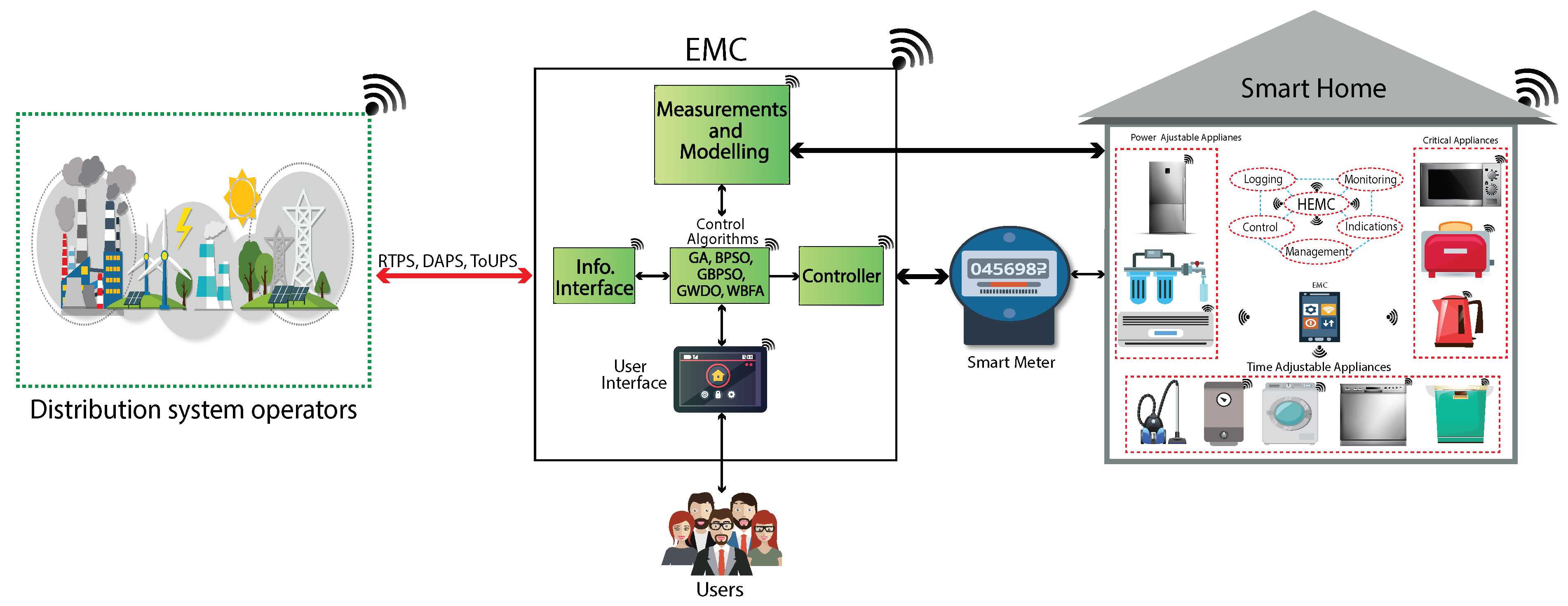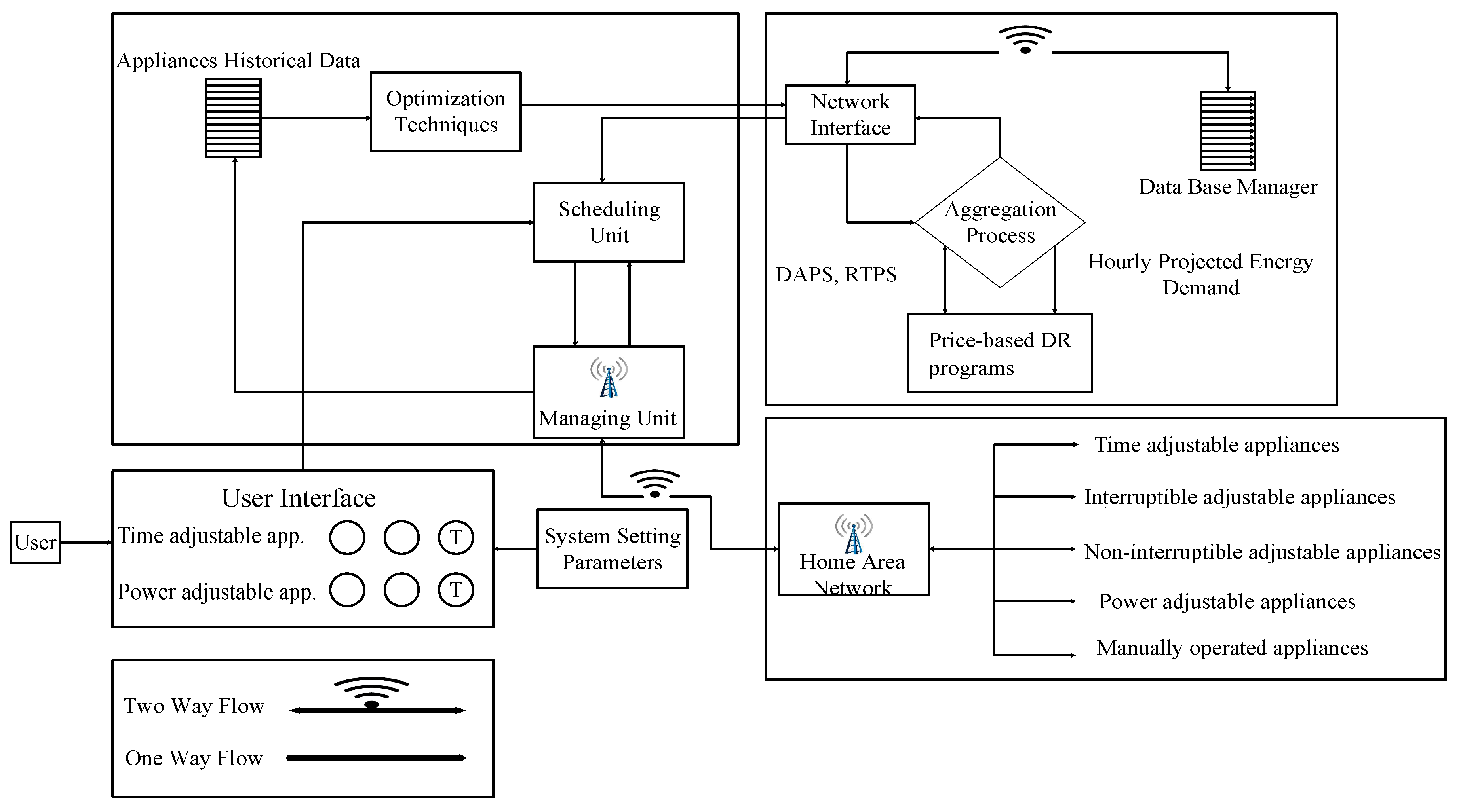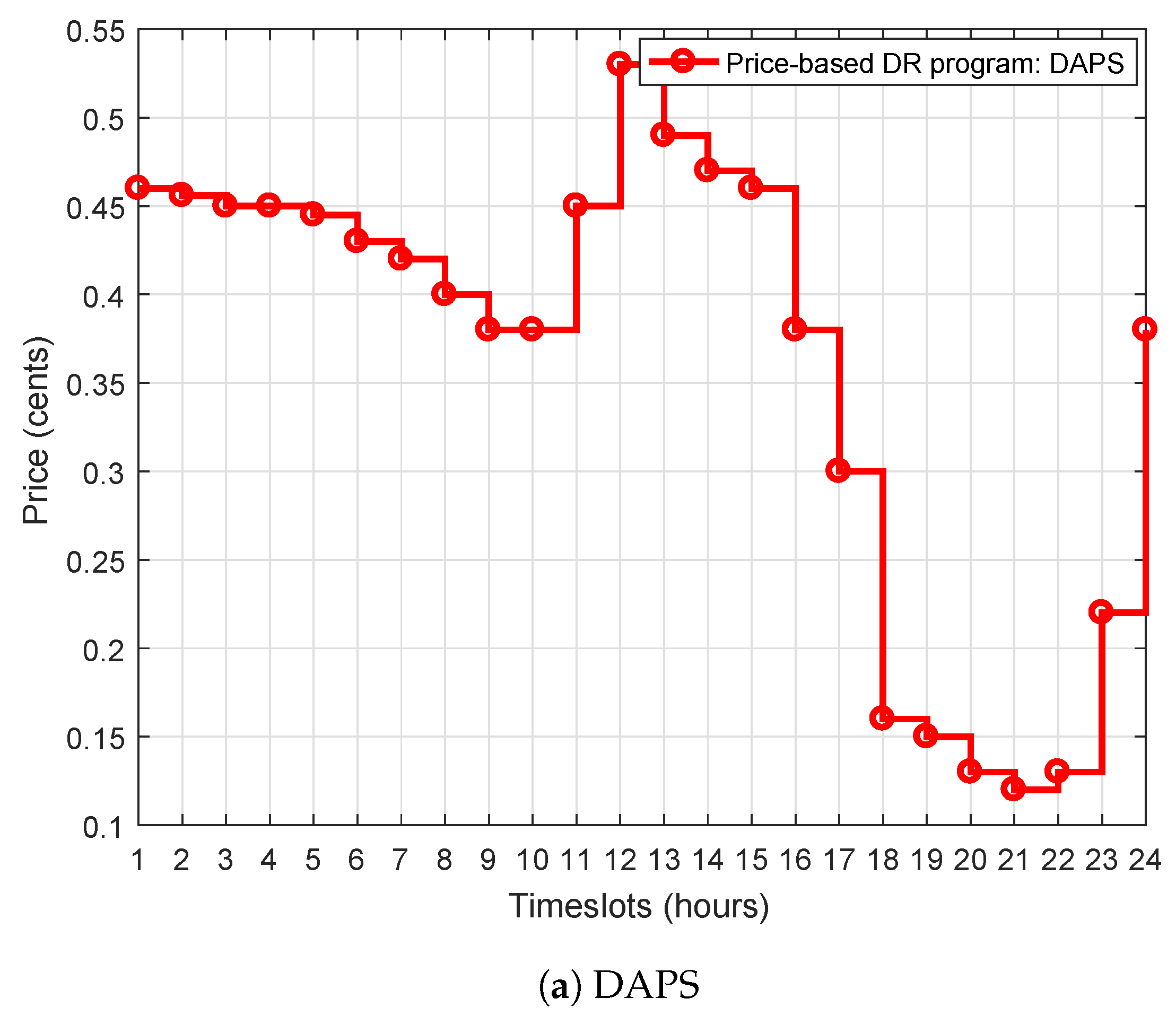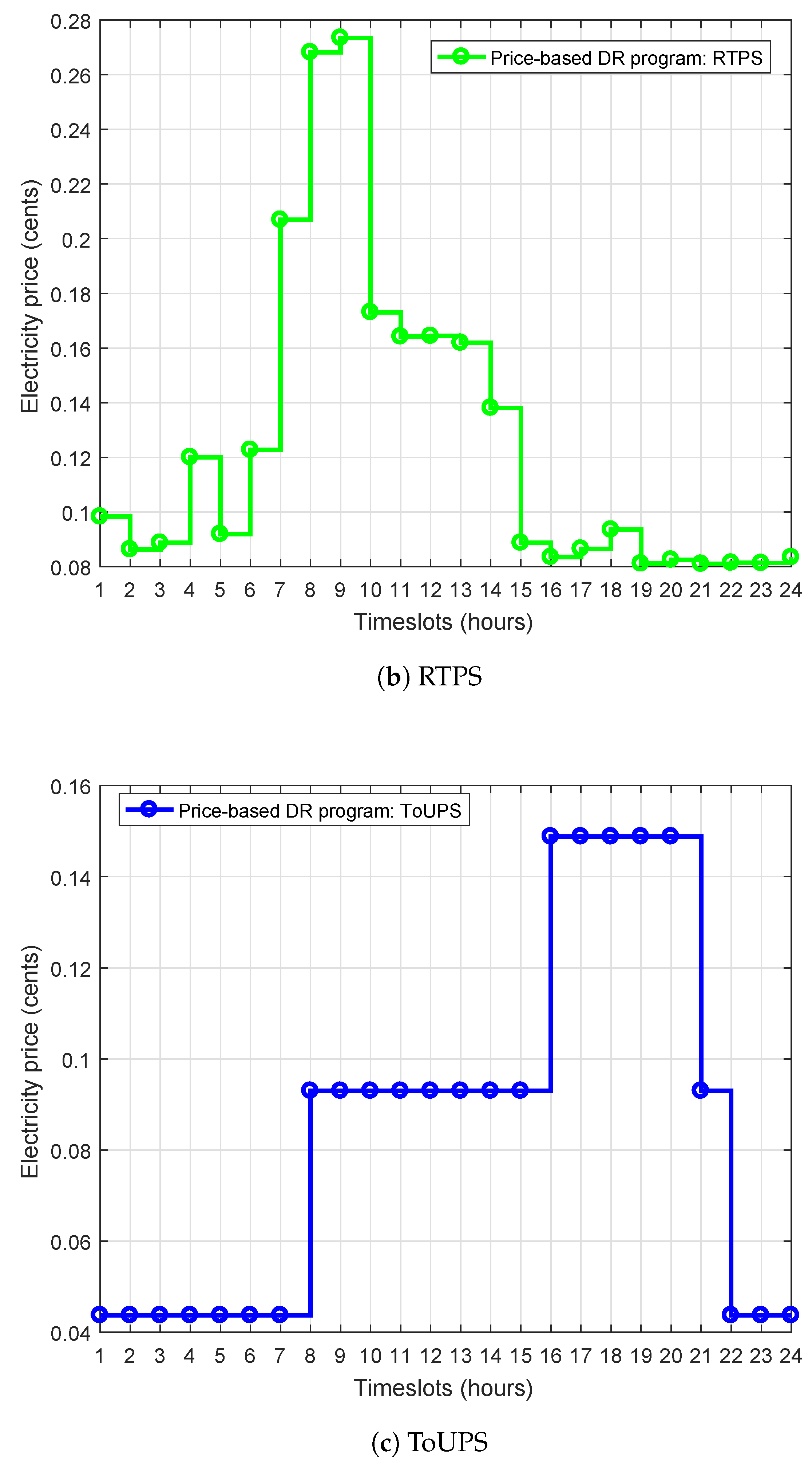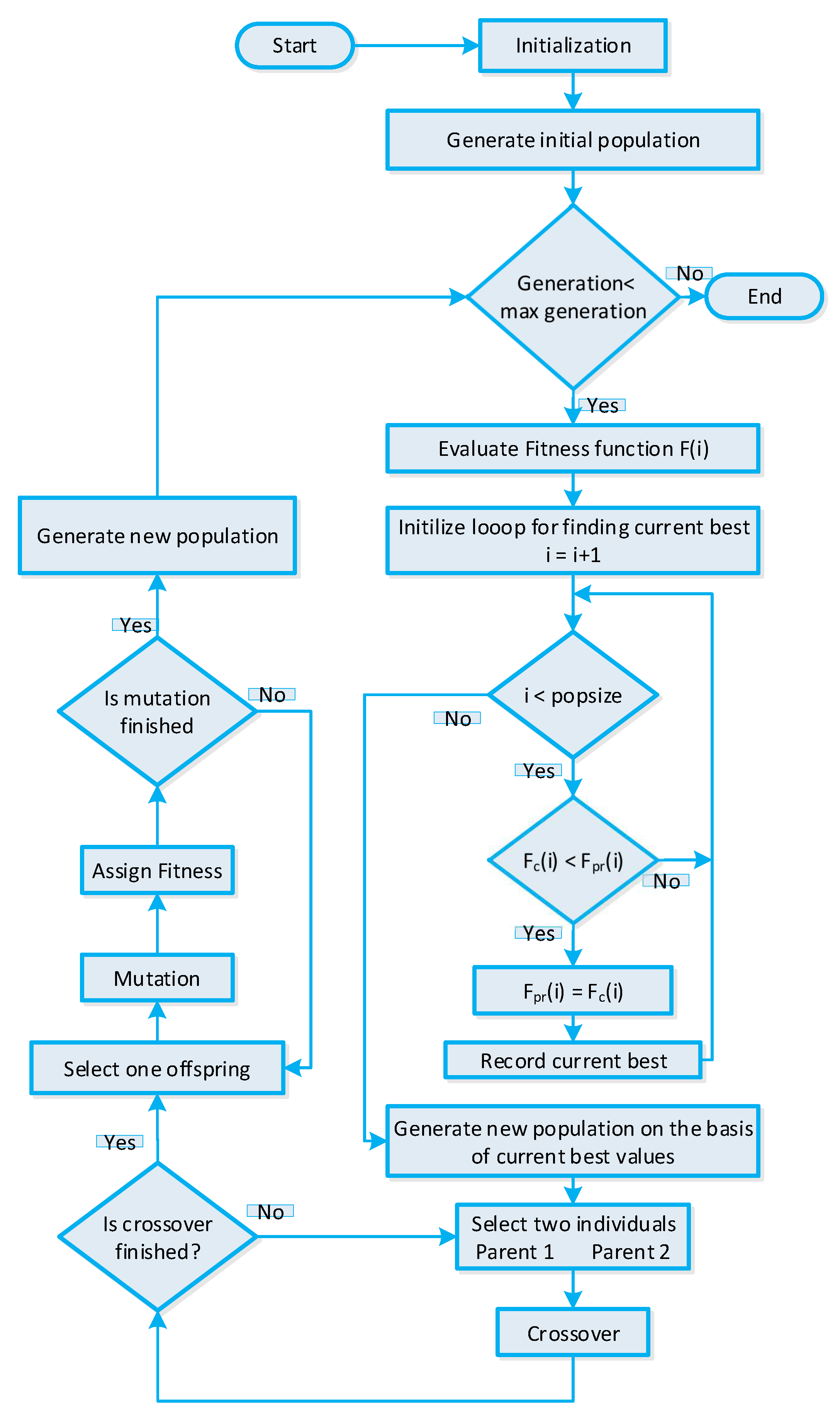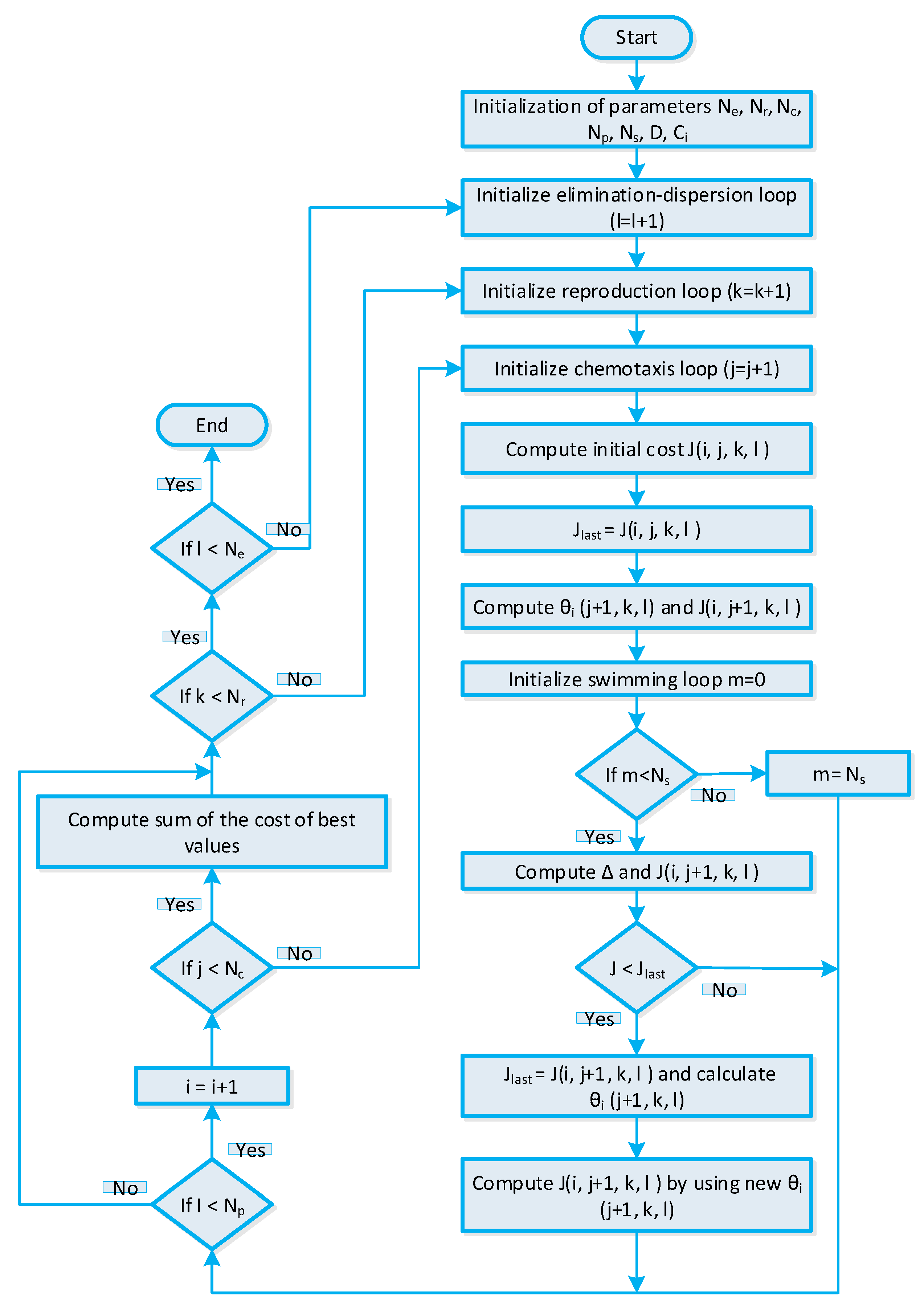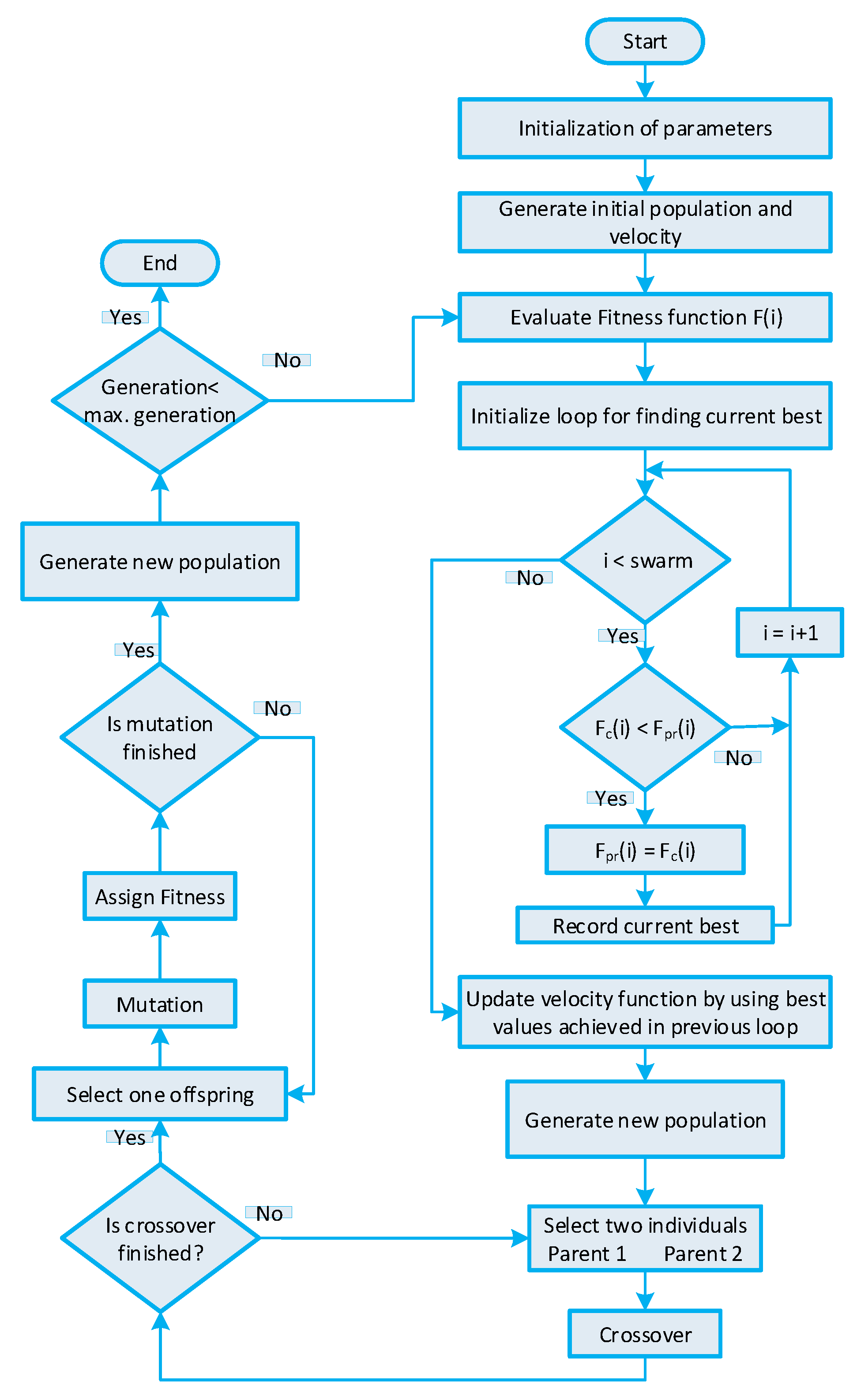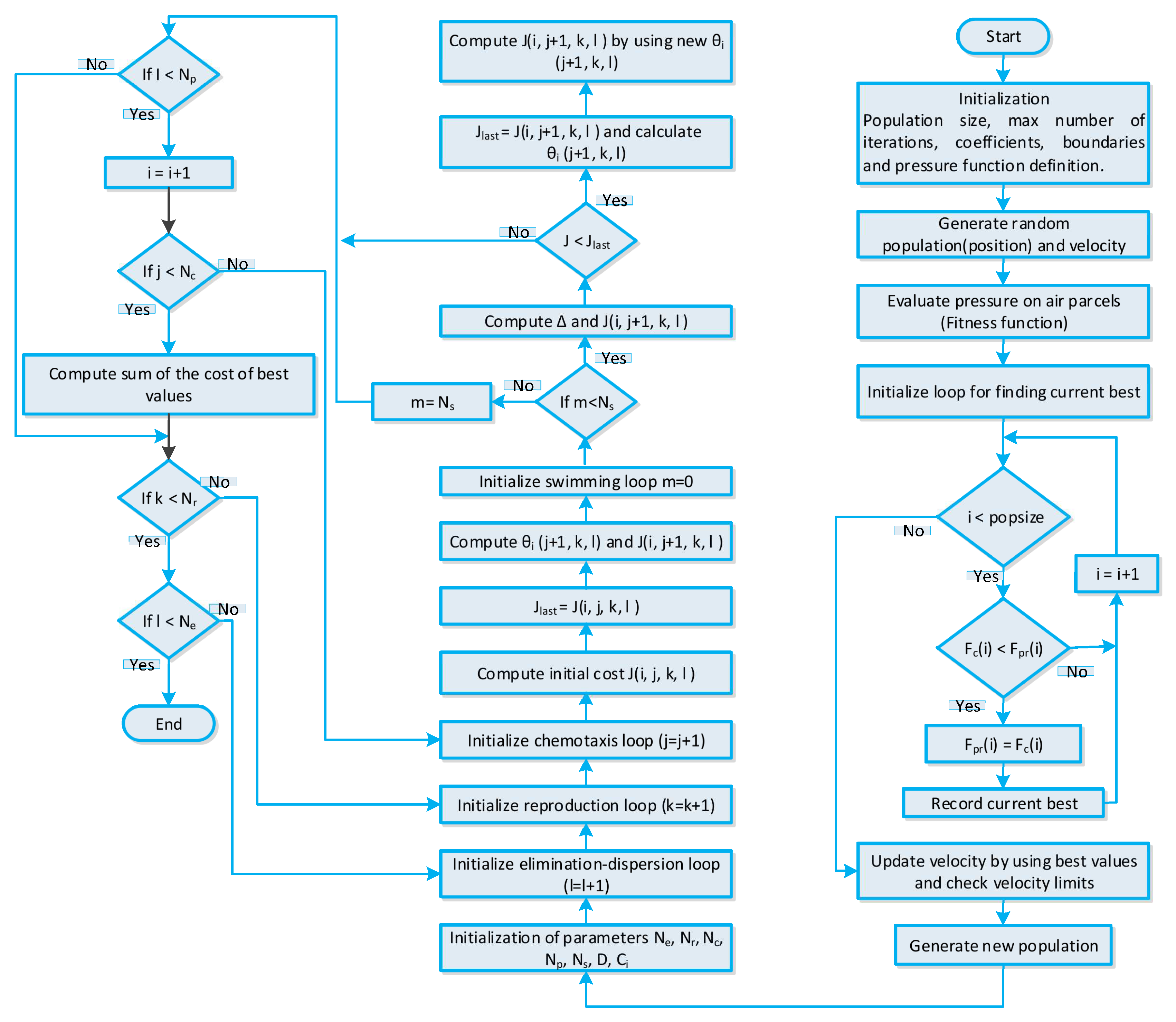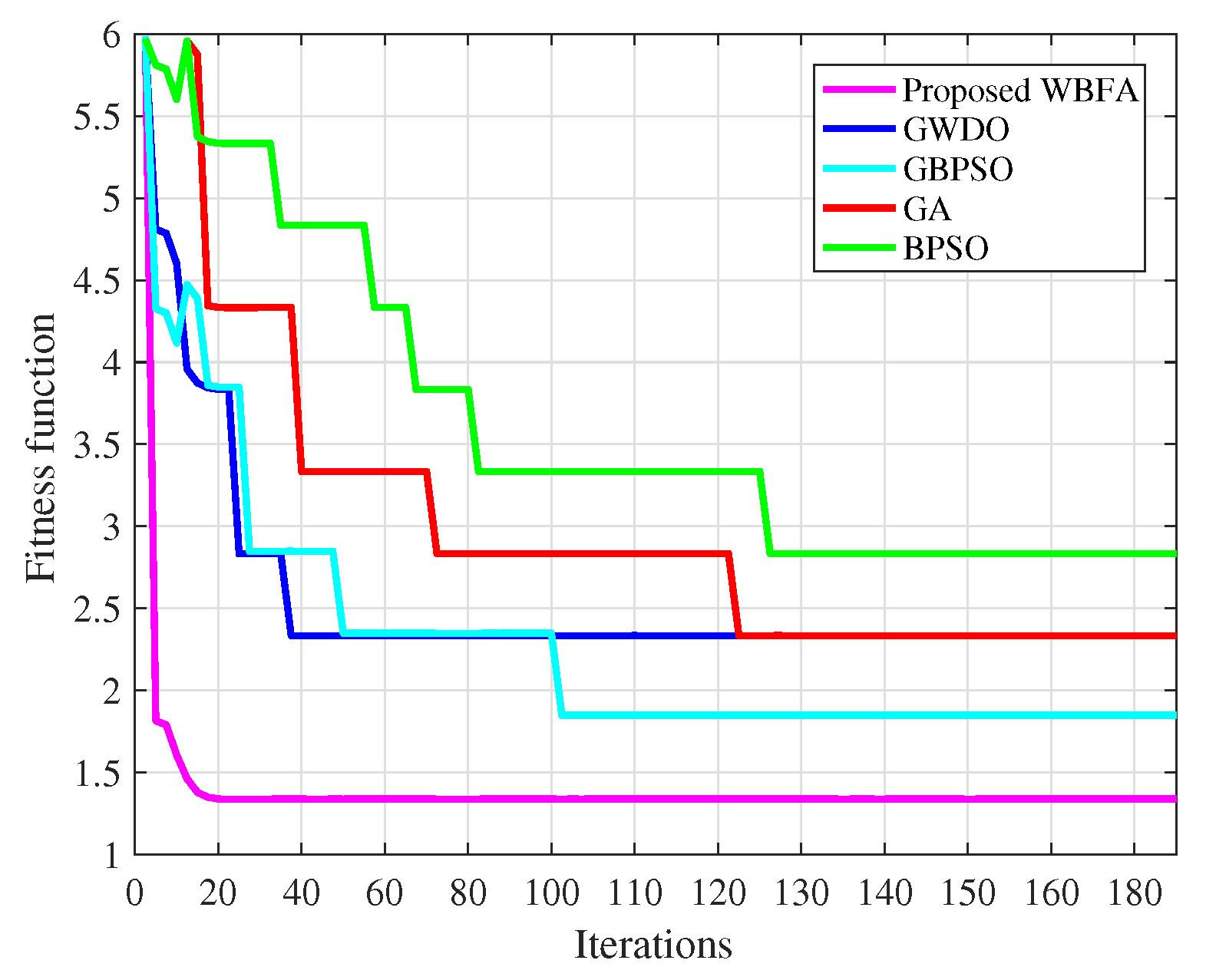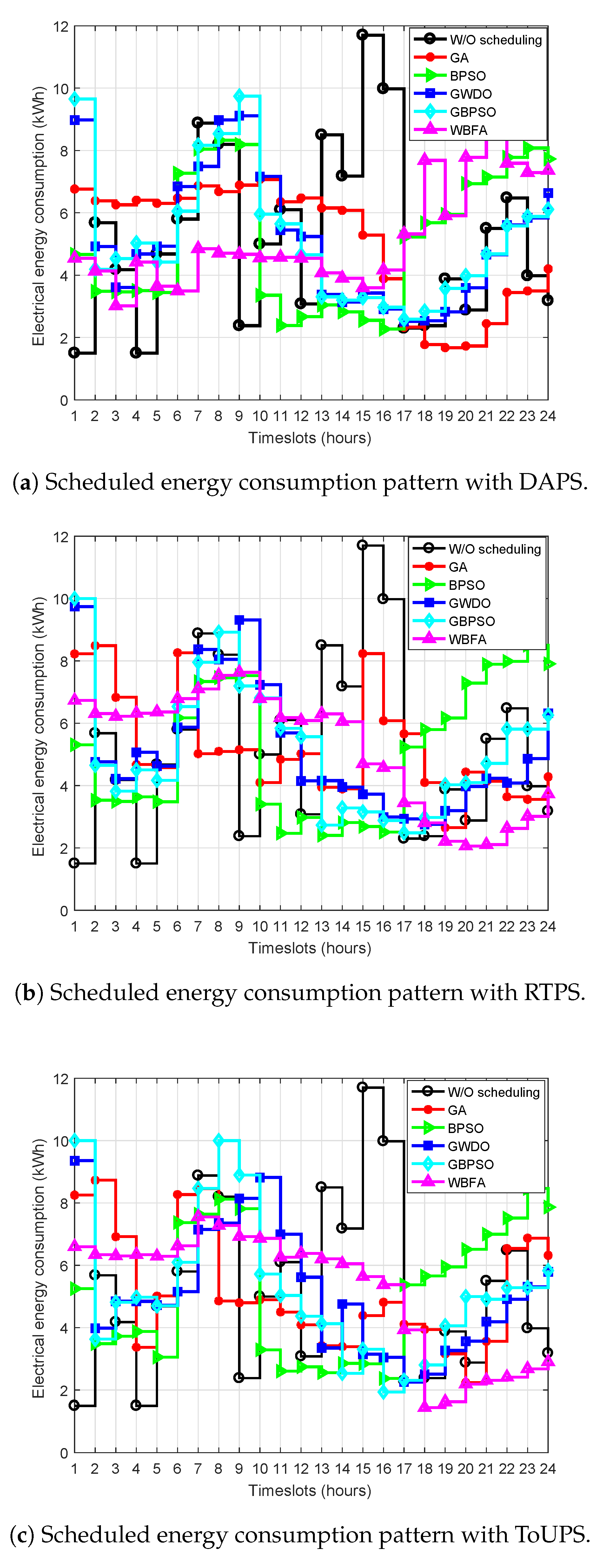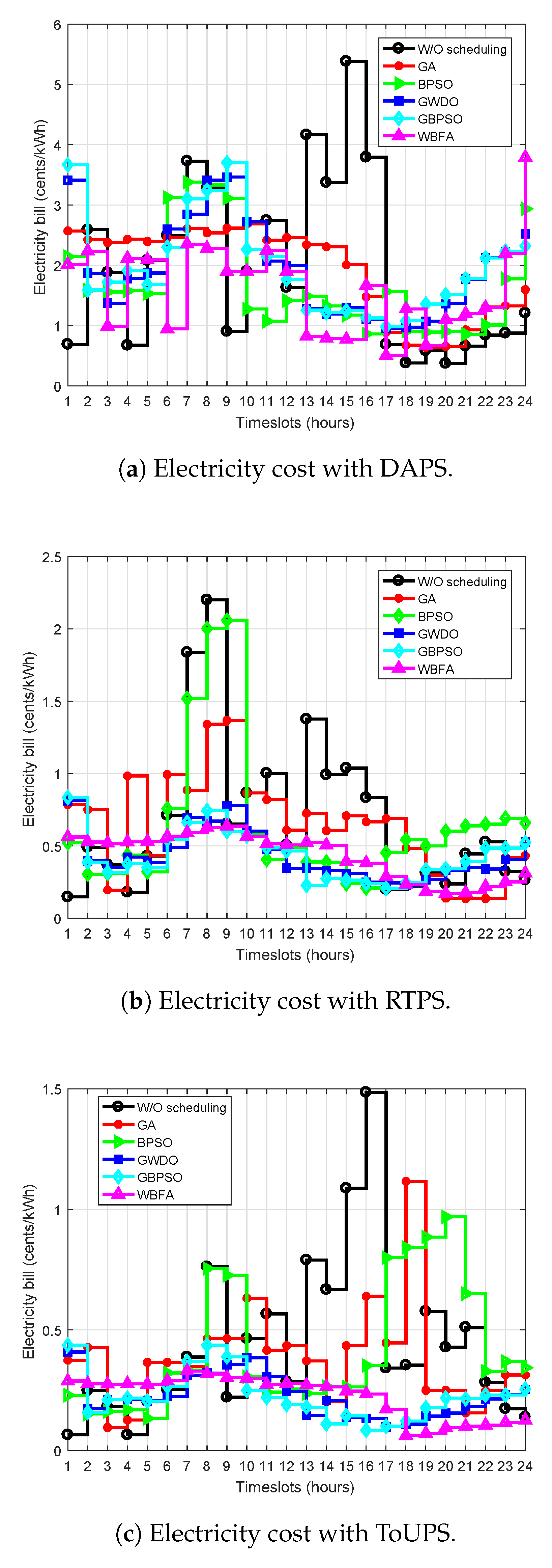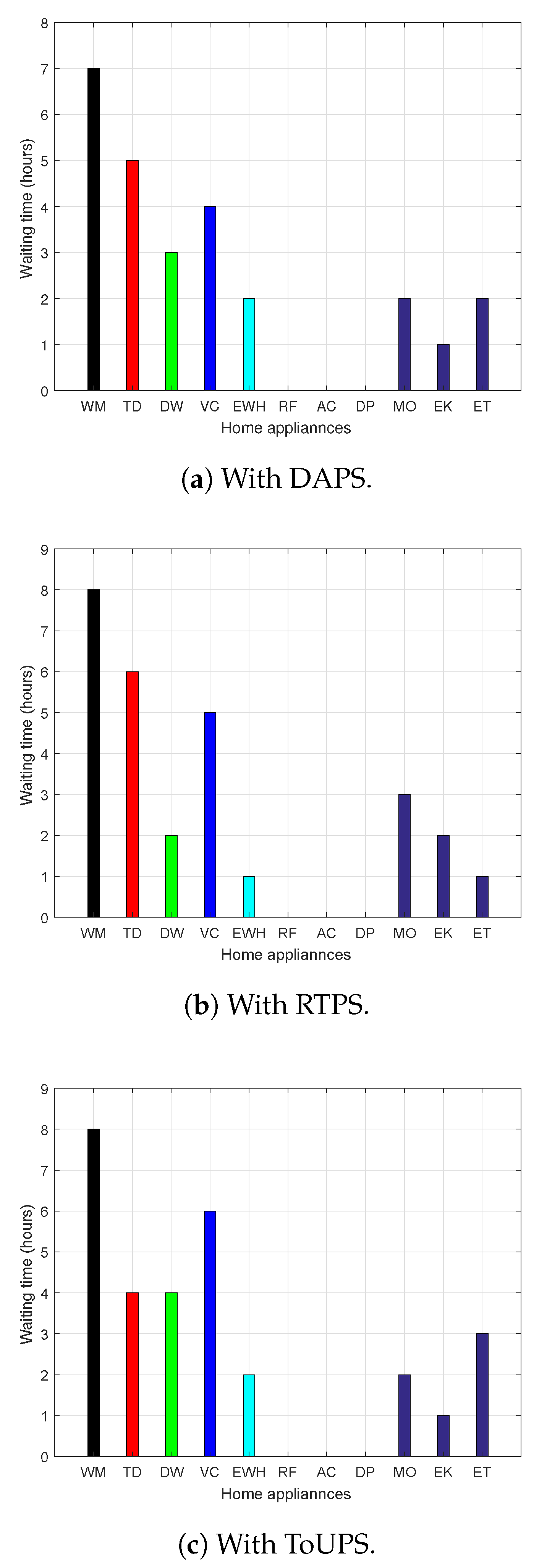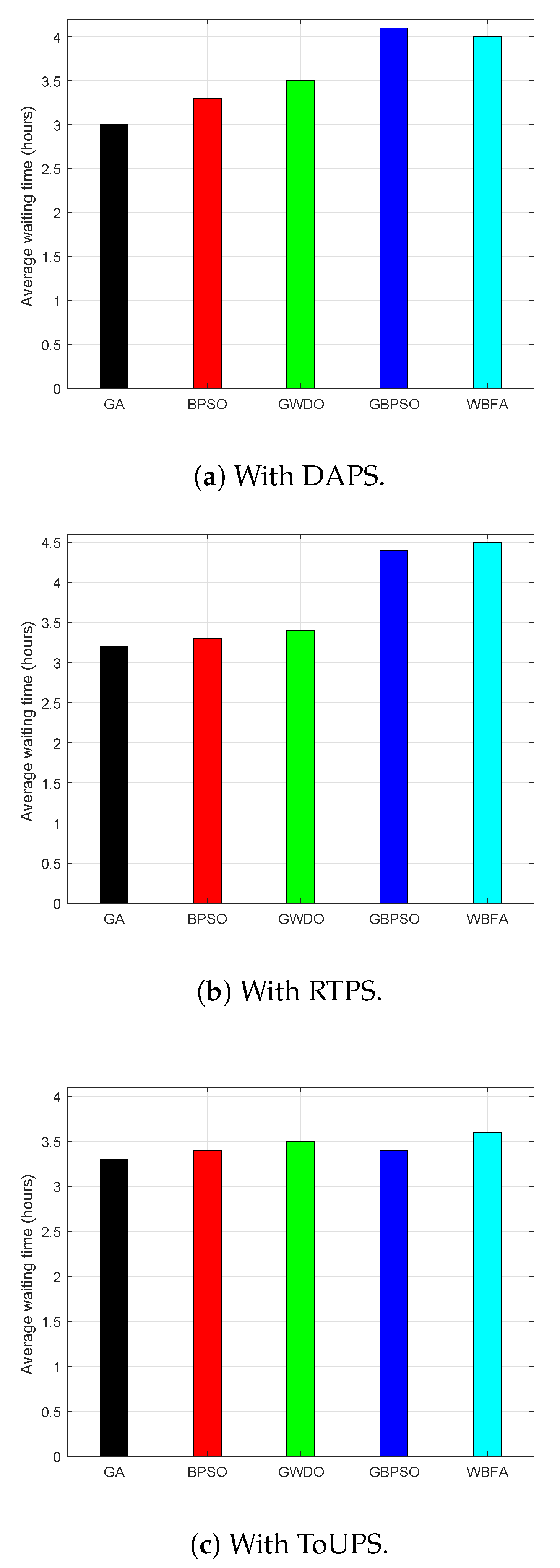1. Introduction
With the rapid growth in population and economic development, dependence on electrical energy is ever so increasing and, consequently, the energy consumption is on the hike. To further emphasize, the authors recorded that the electricity demand of the energy sector will increase to 40% and both the commercial and residential sectors will increase to 25% by 2025 [
1]. The obsolete electric grid is not capable of coping with this rising electricity demand and contemporary challenges like hybrid generation, two-way communication, and two-way power flow. Therefore, the modern power grid, namely smart grid (SG), developed as intelligent electric grid that accommodates internet-of-things (IoT), modern control technologies, information and communication technologies (ICTs), two-way power flow, and hybrid generation. In order to cope with this rising electricity demand, SGs may actively involve either of the two programs: installation of power generating plants or broadcast demand response (DR) programs for energy management [
2].
DR programs are the key incentive programs of the SGs that persuade consumers to participate in the electricity market via advanced metering infrastructure (AMI). The DR programs have two classes: (a) incentive-based DR programs and (b) price-based DR programs. In (a), distribution system operators (DSOs) are IoT-enabled agents that remotely control consumer’s appliances when needed with short notice beforehand. In (b), IoT-enabled users are stimulated to spontaneously manage their power usage in response to offered price-based incentives [
3]. Since residential buildings have an energy consumption of more than 80%—a remarkable portion of the total energy—(b) is an imperative program that produces affirmative results for both DSOs and consumers while performing energy management [
4].
In DR programs, one challenge is the lack of user knowledge which prevents users from participation [
5]. One of the developed solutions is to employ automatic controllers in users’ premises that actively participate and contribute to solving an optimization problem, known as energy management controller (EMC). The EMC when enabled with IoT will effectively minimize consumer’s cost of electricity without sacrificing UC, which is a motivation for end-users to take part in DR programs [
6]. The EMC output is the optimal power usage schedule of residential building smart appliances. Besides, smart appliances, plugin hybrid electric vehicles (PHEVs), renewable energy sources (RESs), and energy storage systems may penetrate to residential buildings in order to improve sustainability [
7,
8]. Thus, in-home PHEVs and energy storage systems facilitate consumers to store energy from RESs during daytime and discharge during nighttime to return many benefits from the investment. However, objectives are achieved at high capital cost. The authors in References [
9,
10,
11] proposed power usage scheduling strategies for residential buildings energy management. The developed strategies are affective in minimizing cost of electricity as well as peak electricity demand. Moreover, in these works, users are attracted to active participation due to cost minimization without sacrificing UC. The authors introduced a novel concept of user priority in energy management systems via power usage scheduling using DR programs [
12,
13,
14,
15,
16]. Home appliances with priority as well as thermal and operational constraints enable EMC to turn on and off appliances on a priority basis.
The above literature provides enough studies relevant to the theme of efficient energy management in SG. Though the focus of some studies is on minimization of cost, some studies catered peak demand reduction, some studies catered alleviation peak-to-average ratio (PAR), and some studies handled UC. To the best of our knowledge, none of the aforementioned studies fully utilized AMI, DR programs, and IoT-enabled environments of the SG to satisfy users and DSOs both parties at the same time. Therefore, in this study, we utilize AMI, DR programs, and IoT-enabled environments of the SG to perform efficient energy management of residential buildings in smart cities in order to minimize cost, curtail PAR, and maximize UC, simultaneously for both users and DSOs satisfaction. The highlights and distinguishing features of this study are given below:
A practical optimization model is formulated for efficient energy management of residential building by power usage scheduling of IoT-enabled smart appliances utilizing AMI and different DR programs like time of use pricing scheme (ToUPS), day-ahead pricing scheme (DAPS), and real-time pricing scheme (RTPS) of the SG.
The most popular DR programs like ToUPS, DAPS, and RTPS are mathematically modeled and implemented for efficient energy management of residential buildings in smart cities.
In References [
16,
17,
18,
19], minimization of electricity cost, and alleviation of PAR objectives are catered. In this work, in addition to electricity cost and PAR, the UC in terms of waiting time or delay is formulated and investigated to solve the energy management problem by power usage scheduling of residential building smart appliances using DR programs in IoT-enabled environment of the SG.
Optimization problem and constraints are constructed for managing power usage of IoT-enabled residential building smart appliances via scheduling to reduce cost of electricity, alleviate PAR, and maximize UC.
A wind-driven bacterial foraging algorithm (WBFA) is developed for IoT-enabled EMC to actively participate in price-based DR programs in order to return optimal power usage schedule for residential building smart appliances.
The efficacy of the proposed WBFA-based strategy is validated by comparing it to the benchmark strategies based on GA [
15,
16], BPSO algorithm [
17], GBPSO algorithm [
18], and GWDO algorithm [
19] in terms of objectives.
The rest of this manuscript is arranged in this manner: First, related work is discussed in
Section 2. In
Section 3, the proposed energy management framework is discussed. Energy management via scheduling problem description and formulation are described in
Section 4. Proposed and benchmark strategies are described in
Section 5. Extensive simulations are conducted and their results are discussed in
Section 6. At last, in
Section 7, the manuscript is concluded and also research directions are provided as future work.
3. Proposed Energy Management Framework
The proposed framework is elaborated in this section. The DSOs are IoT-enabled agents that transfer DR programs like ToUPS, DAPS, and RTPS to stimulate IoT-enabled users to actively participate in energy management via power usage scheduling of residential building smart appliances using received DR signals. The proposed framework composed of IoT-enabled DSOs and residential buildings utilizing AMI of the SG. The residential building is enabled with IoT and equipped with EMC, home gateway, smart appliances, smart meter, remote control, indoor display (IDD), and wireless home area network. The schematic diagram of the proposed framework is depicted in
Figure 1.
The AMI is an essential attribute of the IoT-enabled SG that performs a pivotal role in the central nervous system in the area of energy management via power usage scheduling. The AMI is a two-way communication infrastructure between IoT-enabled DSOs and consumers. The key role of AMI is to collect and deliver recorded energy consumption from smart meters to the DSOs and to transmit DR pricing signals from DSOs to consumers via smart meters and residential building gateway in real-time. The residential building gateway could be separate equipment or might be an integrated entity with smart meter that establish an interface between HAN and wired network. The smart meter could be an indoor or outdoor entity installed in residential buildings between EMC and AMI. The key responsibility of smart meter is to measure, record, and process consumed energy data, and delivered it to the DSOs. Furthermore, it sends DR pricing signals to the IoT-enabled EMC to perform efficient energy management.
In this study, the residential building under consideration is equipped with smart appliances like power adjustable appliances, critical appliances, and time adjustable appliances. The power adjustable appliances have elastic rated power and follow a pre-defined operating schedule. The time adjustable appliances have an elastic operational time and are designed to operate with fixed power rating. They are further classified into two classes like interruptible (dishwasher, tumble dryer, and washing machine) and non-interruptible (electric water heater and vacuum cleaner) [
18]. The IoT-enabled EMC is employed in the residential buildings, which is programmed with our proposed WBFA to respond in real-time to receive DR pricing signals to combat the limitation of the dearth of users’ knowledge, which is the hurdle that prevents implementation of DR programs. The employed WBFA-based EMC enabled with IoT takes smart appliances power rating, price-based DR programs, length of time operation, and accessible power grid energy as inputs in order to schedule power usage of residential building smart appliances in the presence of objective function and constraints. The IoT-enabled EMC in a residential building can communicate with smart appliances through diverse communication links like Wi-Fi, ZigBee, HomePlug, and Z-Wave in order to share the generated power usage schedule with smart appliances. The energy management process of the residential building via power usage scheduling of smart appliances is monitored through IDD or remotely through laptops or mobile phones using the IoT facility. All of the processes is illustrated through the working flow in
Figure 2.
The proposed energy management framework aims to remotely control and monitor the power usage of residential building smart appliances in order to manage energy by scheduling without human intervention using DR programs. The major objectives of the proposed energy management framework are given below:
These objectives are achieved by employing WBFA-based EMC that schedules power usage of residential building smart appliances using price-based DR programs by effective energy utilization in the IoT-enabled environment in the SG.
3.1. Proposed Framework Inputs
Inputs to the proposed framework are available energy from power grid, DR programs, appliances power rating, length of time operation, and power usage pattern. The detailed demonstration of the inputs are given below.
3.1.1. Residential Building Smart Appliances
The residential building (smart home) is equipped with smart appliances like power adjustable appliances
, time adjustable appliances
, and critical appliances
. The residential building smart appliances have the following parameters that are clearly defined operational time interval, power rating, priority, category, status, and position. The mathematical description is as follows:
The status indicator and position indicator for every smart appliance a at timeslot t are defined, where represents an appliance remaining timeslots, and represents an appliance waiting timeslots. The detailed demonstration is given below:
Smart appliance input parameters equipped with the residential building are briefly described and presented in
Table 3.
3.1.2. ToUPS, DAPS, and RTPS Price-Based DR Programs
This study introduces ToUPS, DAPS, and RTPS price-based DR programs that are fed as an input to our proposed WBFA-based EMC in the IoT-enabled environment. These DR pricing signals are delivered by DSOs to the WBFA-based EMC to schedule the power usage of smart appliances in order to minimize the cost of electricity, alleviate PAR, and maximize UC. These price-based DR programs are adopted from federal energy regulating commission (FERC) [
52] as shown in
Figure 3. The DAPS price-based DR program is commonly used for household load scheduling of IoT-enabled smart cities. In DAPS, price-based DR programs have three price levels for the complete day, like high, medium, and low price hours as shown in
Figure 3. In similar passion, RTPS is defined for the whole day with hour resolution as depicted in
Figure 3. Similarly, ToUPS price-based DR programs have also three varying price levels: off, mid, and on-peak price hours. The ToUPS is mathematically modeled as follows:
where
is the ToUPS electricity price at timestep
t and
,
, and
are the prices at off-peak, mid-peak, and on-peak periods, respectively. The ToUPS is defined for the whole day with hour resolution or alternatively
and
. The ToUPS price-based DR program is also illustrated in
Figure 3. The time interval from 1 to 8 and 22 to 24 h are off-peak hours and corresponds to
and
of Equation (
9). Similarly, the time intervals from 8 to 16 and 21 to 22 h are mid-peak hours reflecting
and
in Equation (
9). Furthermore, the time interval from 16 to 21 h is on-peak hours and indicates
and
in Equation (
9). The EMC based on our proposed WBFA shifts the power usage from on-peak hours to off-peak hours in order to minimize cost electricity, to alleviate PAR, and to maximize UC in IoT-enabled environment of the SG.
3.2. Proposed Framework Outputs
The WBFA-based EMC utilizes residential building smart appliance parameters (operation time interval, power rating, priority, status, etc.), price-based DR programs, and accessible power grid energy as inputs to solve the optimization problem by scheduling power usage of residential buildings under IoT-enabled environment of the SG. The smart appliances of the residential building follow the schedule assigned by WBFA-based EMC to minimize cost, to alleviate PAR, and to maximize UC by effective energy utilization. The output of the proposed framework is an optimal power usage schedule of smart appliances of a residential building which actively participate in the energy management area of the SG.
6. Simulation Results and Discussion
Extensive simulations are conducted to validate our proposed WBFA-based strategy in terms of energy management using price-based DR programs as depicted in
Figure 3a–c, respectively. For simulations, MATALAB
® M-file platform is utilized installed on Intel
® Core™ i3-3420M CPU @ 2.4 GHz and 6 GB RAM with Windows 10. The DAPS price-based DR program has three price levels: low, medium, and high, as shown in
Figure 3a. The high-price hours are also known as on-peak hours. Its duration spans from 11 to 16 h. The medium-price hours are also termed as mid-peak hours. Its duration ranges from 1 to 11 h; likewise, a low-price hour is also named as off-peak hours. Its range spans from 18 to 23 h. The remaining timeslots are assumed as medium-price hours. Likewise, RTPS-based price-based DR program has also three price hours: high-price hours ranging from 7 to 10 timeslots, medium-price hours spanning from 11 to 15 timeslots, and the rest of the timeslots as low-price hours. The ToUPS price-based DR program has also three levels likewise DAPS and RTPS price-based DR programs: high-price hours spanning from 16 to 21 timeslots, medium-price hours, and low-price hours. The proposed WBFA-based strategy is compared with benchmark strategies based on GA [
15,
16], BPSO algorithm [
17], GBPSO algorithm [
18], and GWDO algorithm [
19] in simulations. These existing strategies are selected due to architecture resembling the proposed WBFA-based strategy. For performance evaluation of the proposed WBFA based strategy, four performance metrics are selected from the pool of metrics: (a) cost of electricity, (b) energy consumption, (c) PAR, and (d) UC.
The power usage of residential building smart appliances is scheduled using price-based DR programs as depicted in
Figure 13a–c to minimize the cost of electricity, to alleviate PAR, and to maximize UC by efficient energy utilization. The overall power usage profile before scheduling and after the scheduling of residential building smart appliances is shown in
Figure 13. The proposed and benchmark strategies are capable of scheduling power usage of the IoT-enabled residential buildings by employing DAPS price-based DR program as depicted in
Figure 13a.
Figure 13a depicts that both strategies have shifted load from high-price hours to low-price hours by employing DAPS price-based DR program. However, it is obvious that our proposed WBFA-based scheduled power usage profile is comparatively most favorable. The peak power usage of the proposed WBFA-based strategy and benchmark strategies during high-price hours are 4 kWh, 2.3 kWh, 2.2 kWh, 2.4 kWh, and 6.2 kWh, respectively. Therefore, from
Figure 13a, it is obvious that the proposed WBFA-based strategy has comparatively average peak power usage. Which is the evidence that proposed WBFA-based strategy schedules power usage of residential building smart appliances in such a manner to minimize the cost of electricity and to maximize UC. The benchmark strategies only catered PAR and cost of electricity. In contrast, when our proposed WBFA-based strategy is not adopted by the users, then they purchase energy from 2 to 9 timeslots and 13 to 17 timeslots, which are medium- and high-price hours that result in peak energy consumption and overwhelm the power grid. Likewise, power usage scheduling of residential building smart appliances using RTPS of proposed and benchmark strategies and before scheduling scenarios are illustrated in
Figure 13b. The peak power usage of the proposed WBFA-based strategy is 6 kWh, BPSO is 2 kWh, GA is 7.1 kWh, GBPSO is 3 kWh, and GWDO is 3.9 kWh as illustrated in
Figure 13b. Thus, the proposed WBFA-based strategy has average peak power usage as compared to benchmark strategies. This average peak power consumption of the proposed WBFA-based strategy is due to optimal power usage scheduling of residential building smart appliances keeping in view all objectives. On the other hand, the focus of benchmark strategies is only on cost and PAR. The power usage of residential building smart appliances scheduling using ToUPS price-based DR program for the proposed WBFA based strategy and benchmark strategies is shown in
Figure 13c. The proposed WBFA-based strategy has a peak power consumption of 5.2 kWh, which is average peak power consumption when comparatively analyzed. The reason for this optimal performance of our proposed strategy is that it performs energy management via power usage scheduling of residential building smart appliance keeping in view UC. On the other hand, benchmark strategies focus only on the cost of electricity and PAR while ignoring UC.
The cost of electricity per hour analysis of the proposed and benchmark strategies for consumed electricity is shown in
Figure 14.
Figure 14a clearly demonstrates that both strategies (proposed and benchmark) can minimize cost of electricity by scheduling under DAPS price-based DR program as compared to without power usage scheduling. However, it is obvious that the overall cost of electricity per hour of our proposed WBFA-based strategy is low as compared to benchmark strategies. On the other hand, cost of electricity of our proposed WBFA-based strategy during high-price hours is high because of the consideration of UC. The cost of electricity per hour of the proposed WBFA-based strategy and benchmark strategies using RTPS price-based DR program is shown in
Figure 14b. It is obvious that our proposed WBFA-based strategy scheduling is optimal as compared with benchmark strategies, and consequently, users enjoy the lowest per hour cost of electricity. Likewise, in the case of ToUPS price-based DR programs, the lowest cost of electricity per hour of the proposed WBFA-based strategy as compared to benchmark strategies is also shown in
Figure 14c.
The aggregated cost of electricity numerical values evaluation for both the proposed WBFA-based strategy and benchmark strategies is illustrated in
Figure 15. Aggregated cost per day evaluation of the proposed WBFA-based strategy and benchmark strategies for the DAPS price-based DR program is shown in
Figure 15a. The net costs of electricity per day of benchmark strategies like GBPSO, GWDO, GA, BPSO, and our proposed WBFA-based strategy are 36 cents, 35 cents, 42 cents, 37 cents, and 34 cents, respectively. The percent decrements of benchmark strategies like GBPSO, GWDO, GA, BPSO, and our proposed WBFA-based strategy are 23.4%, 25%, 10.6%, 21.2%, and 27.6%, respectively. From numerical results, it is obvious that the WBFA-based strategy has minimized the aggregated cost of electricity per day remarkably as compared to the benchmark strategies and without power usage scheduling. The net cost of electricity per day of the proposed WBFA-based strategy and benchmark strategies under the RTPS price-based DR program is illustrated in
Figure 15b. The aggregated costs of electricity of the benchmark strategies like GBPSO, GWDO, GA, BPSO, and our proposed WBFA-based strategy are 10.3 cents, 10.1 cents, 15 cents, 16 cents, and 9.5 cents, respectively. Likewise, the aggregated cost using ToUPS price-based DR program of the proposed WBFA-based strategy and benchmark strategies is shown in
Figure 15c. Our proposed WBFA-based strategy outperforms existing strategies (GA, BPSO, GBPSO, and GWDO) in terms of electricity bill reduction. The percent decrement of our proposed strategy is 52.10%, which the higher reduction in the bill as compared to the reductions in the electricity bills of GA, BPSO, GBPSO, and GWDO, which are 12.70%, 4.2%, 48.10%, and 50.20%, respectively. The statistical observations of cost of the proposed WBFA-based strategy and existing strategies using DAPS, RTPS, and ToUPS DR programs are listed in
Table 6,
Table 7 and
Table 8, respectively. It is concluded that the proposed WBFA-based strategy outperforms existing energy management strategies in terms of electricity cost minimization.
Proposed WBFA-based strategy and existing strategies evaluation in terms of PAR using ToUPS, DAPS, and RTPS price-based DR programs is shown in
Figure 16. The evaluation of both strategies (proposed and existing) in terms of PAR using DAPS is shown in
Figure 16a. The users who have not employed our proposed strategy or existing strategies for scheduling have very high PARs of 5. When users employ existing strategies like GWDO, GBPSO, GA, BPSO, and our proposed WBFA-based strategy, the power usage scheduling leads to reduced PAR of 3.8, 3.6, 3.7, 3.1, and 2.1, respectively. Thus, our proposed WBFA-based strategy minimizes cost as well as alleviates PAR by 58%, which is indispensable for SG reliable operation. Likewise, our proposed WBFA-based strategy curtailed PAR by 54% and 62% with RTPS price-based DR program (refer to
Figure 16b) and with ToUPS price-based DR program (refer to
Figure 16c), respectively. The percent decrement in PAR of our proposed WBFA-based strategy and existing (GA, BPSO, GWDO, and GPSO) strategies using DAPS, RTPS, and ToUPS price-based DR programs is listed in
Table 9,
Table 10 and
Table 11, respectively.
UC and discomfort analysis of the proposed strategy using price-based DR program is depicted in
Figure 17. The frustration faced by consumers in terms of waiting time with the proposed strategy under the DAPS price-based DR program is depicted in
Figure 17a. The user discomfort (waiting time) and electricity cost are inversely related, and trade-off exists between waiting and electricity cost. The waiting time of all appliances in the IoT-enabled smart home is numerically visualized in
Figure 17a; the waiting times of time adjustable appliances, critical appliances, and power-adjustable appliances are high, medium, and low, respectively. The high waiting time of time-adjustable appliances is due to their delay-tolerant nature, and these appliances contribute to the electricity bill reduction. On the other hand, the waiting time of power-adjustable appliances is low because they are not delay-tolerant and take part in scheduling through their power flexible nature. In a similar manner, the waiting time of all smart appliances in IoT-enabled residential building is numerically visualized in
Figure 17b,c using RTPS and ToUPS, respectively.
Observation of average waiting time for the proposed and existing energy management strategies in terms of numerical values is illustrated in
Figure 18. The average waiting times of the proposed WBFA, and GA, BPSO algorithm, GWDO algorithm, GBPSO algorithms are 4 h, 3 h, 3.3 h, 3.5 h, and 4.1 h, respectively, using DAPS, as depicted in
Figure 18a. In terms of average waiting time, the GA-based strategy is superior to all strategies. The most suitable reason for this behavior is the existence of a trade-off between electricity cost and average waiting time. The average waiting time of our proposed WBFA-based strategy is high because electricity cost and PAR are reduced at the cost of moderate user discomfort. The average waiting time (user discomfort) is reduced at the expense of high electricity bill payment, as shown in
Figure 18b. The average waiting times under RTPS of the proposed WBFA, and existing GA, BPSO algorithm, GWDO algorithm, GBPSO algorithms are 4.5 h, 3.2 h, 3.3 h, 3.4 h, and 4.4 h, respectively. In a similar passion, user discomfort is reduced at the expense of high electricity bill payment, as depicted in
Figure 18c.
7. Conclusions and Future Research Directions
Electricity efficient utilization, optimal electricity consumption, and cost minimization can be acquired by employing DR programs. However, the dearth of knowledge prevents the development and employment of DR programs in consumer premises. Diverse methods like classical, mathematical, heuristic, meta-heuristic, and hybrid are applied to implement and employ DR programs for energy management of the residential building in IoT-enabled environment of the SG. In this work, we propose the WBFA algorithm, which is a hybrid of the WDO and BFO algorithms. The EMC programmed with our proposed WBFA algorithm automatically responds to DR programs to participate in the energy management of the residential building in IoT-enabled environment of the SG. We adopted DAPS, RTPS, and ToUPS price-based DR programs; our proposed WBFA-based strategy schedules power usage of residential building smart appliances under these DR programs. The objective of our proposed WBFA-based strategy is to minimize the cost of electricity, to alleviate PAR, and to maximize UC. Simulation results demonstrate that employing ToUPS DR program for energy management leads to the lowest cost of electricity, PAR, and stable power usage schedule of residential building smart appliances compared to DAPS and RTPS DR programs. Furthermore, our proposed WBFA-based strategy minimized cost of electricity and PAR by 27.6% and 58% by employing the DAPS DR program, by 40% and 54% by employing the RTPS DR program, and by 52.1% and 62% by employing the ToUPS DR program, respectively, as compared to without employing price-based DR programs. Thus, employing ToUPS DR program for energy management leads to providing favorable outcomes for both consumers and DSOs.
This study can be extended into various directions in the future:
The energy management via scheduling can be performed through the coordination of residential building smart appliances in the presence of power grid, RE, energy storage systems, and EVs by embedding sensors on the participant. To handle such a coordinated environment, the EMC would be made intelligent and smart by incorporating sensing, communication, and the IoT modules on the traditional EMC. Furthermore, for this coordinated environment, net metering is required where consumers would become prosumers. The prosumers can generate renewable energy and store it into the energy storage system and EVs that have storage batteries. The prosumers sell their generated and stored energy back to the power grid in order to ensure reliable, stable, sustainable, and economical power grid operation. The prosumers enabled with intelligent and smart EMC and net metering features can actively participate in regulated energy markets with price-based DR programs and incentive-based DR in order to facilitate both the power grid and consumers.
This work can be extended to fog- and cloud-based energy management via scheduling using the DR program in the SG.
An energy management model with a hybrid generation (RE and fossil fuel) system can be extended by considering vehicles to grid parking stations as a controllable load based on game-theory-based optimization algorithm.
A MILP-based efficient energy management modular framework may be proposed for both urban and ruler energy systems for performance and sensitivity analysis.
An innovative energy management model may be proposed in cloud computing for efficient load scheduling using a hybrid genetic gravitational search algorithm.
To perform efficient energy management, an intelligent forecaster or machine learning-based forecaster for price and load is required before to schedule the energy consumption pattern of consumers.
In the future, we will engage in some advanced, intelligent, and hybrid appliances that have time as well as power-flexible nature in the energy management strategy. Such types of appliances will provide more opportunities for EMC to engage them in energy management in order to provide economical and sustainable solutions.
